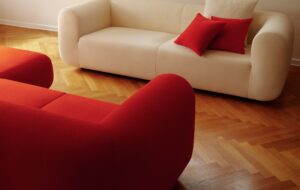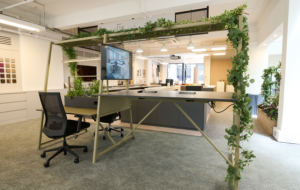Starting out as graphic designers in Queensland, Truly Truly’s fascination for industrial materials led them to three- dimensional space – and Rotterdam, writes Riya Patel
‘The design that we like to do is for people to use. Not just as an artistic statement,’ say Joel and Kate Booy from their studio in Rotterdam. ‘But we don’t want to make things that are too boring either.’
The Australian designers, who operate as Studio Truly Truly, have been making a name for themselves with designs that balance finely between art and function.
From Queensland to Rotterdam
The husband-and-wife team taught creative typography at Griffith University in Queensland, before turning their attention to industrial design. Knowing how to shape and form comes from their background in graphic design, but it’s a fascination for materials that characterises their three-dimensional work.
Changing track brought them to The Netherlands, where they sought somewhere with a ‘different and challenging’ approach. Joel studied at Design Academy Eindhoven, while Kate worked as a graphic designer until they were ready to launch as a studio in 2014.
Colab with IKEA and other projects
The Dutch design scene proved to be an excellent testbed for honing their practice. In 2015, Hella Jongerius noticed the distinct ‘signature’ the studio applies across a variety of media: including resin, woven steel sections and blown glass.She invited the studio to take part in a research project with Textielmuseum, which involved translating complex knit structures from hand to machine.
In the same year, IKEA tapped Studio Truly Truly to work on a sofa, and their response was to strip the typology right back to basics. The bare steel frame has standard cushions that can be strapped into it as the user decides. Its looks are decidedly abstract, but the sofa is a novel take on issues of adaptability, longevity and economy in furniture design.
Truly well-received
Although the designers had exhibited in group shows before 2017, that year’s Salone Satellite was the rst real opportunity to present themselves, and the parts of their portfolio that lend themselves to production. The showcase for young designers and design schools within Milan Furniture Fair can be a mixed a air, but Studio Truly Truly’s stand and collection was well-received, garnering attention from both manufacturers and international media.
Daze, an impeccably finished series of coated-steel side tables, drew some admiring glances in particular. The design came from observing an accidental detail in the powder coating process when different colours are applied to opposing surfaces. The places where one colour spills into the other are emphasised by clean bends and slits in the thin sheet metal. ‘We started with the colouring idea in mind, and developed the shape following that,’ says Kate.
Another exercise in reduction – the Column family of lighting – developed in a similar way. The series of totem-like lamps are made of linoleum flooring and anodised aluminium, with an LED light source concealed in the top.
‘We saw that linoleum has a beautiful texture when you shine a light on it,’ says Joel. ‘We thought to o set that with anodised aluminium, so you get the smooth and shiny, with the earthy linoleum. That’s what gave rise to the shaping.’ Rather than impose a preconceived shape onto either project, Studio Truly Truly let its research dictate how the forms should be. From there, they say methods of repetition and simpli cation allow them to ‘enhance the essence’ of each furniture piece or product.
A nice way to deal with a collection
At IMM Cologne in January 2018, the pair debuted Cilon, a lighting system for Australian brand Rakumba. They worked from a familiar starting point: a typeface with a family of letters. Seven lighting components, each inspired by a different letter, are designed to x to a rail, and can be combined as desired.
Joel says: ‘It was a nice way to deal with a collection: an anchor for how we made all the forms. Some are obvious, and some are abstract.’ Kate adds: ‘It’s designed to work in unison, although the individual elements are completely different.’
So far Studio Truly Truly’s output is the result of spirited enquiry into industrial materials and processes – their studio name is a manifesto to ‘make things properly, honestly and artfully.’ They say the past seven years have been about building up a bank of knowledge and research, but the collection for Rakumba marks a point where they can access real technical expertise and push the capabilities of materials and processes further still. If more manufacturers catch on, it will be an encouraging sign of things to come.















